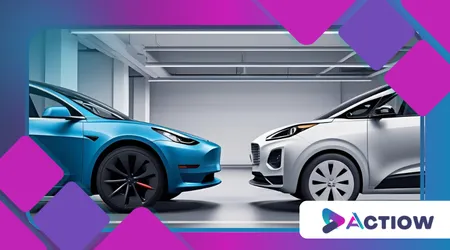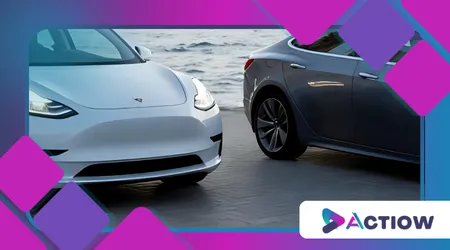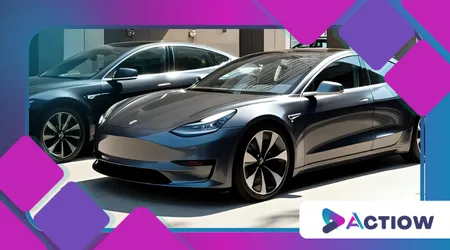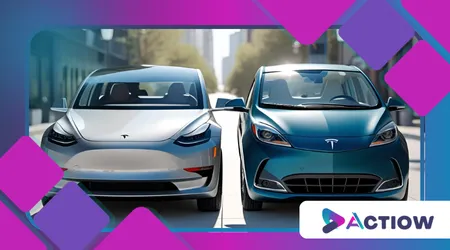Tesla Model 3 vs BYD Seal: Which EV Offers More Value in 2025?
Anúncios
Tesla Model 3 vs BYD Seal: In the rapidly evolving electric vehicle (EV) market, choosing the right car can feel like navigating a maze of specs, prices, and features.
Among the top contenders in 2025 are the Tesla Model 3 vs BYD Seal, two electric sedans that have sparked heated debates among enthusiasts and practical buyers alike.
Tesla Model 3 vs BYD Seal

Both vehicles promise cutting-edge technology, impressive performance, and eco-friendly credentials, but which one delivers the best value for your money?
Anúncios
This article dives deep into their price, performance, features, and overall ownership experience to help you decide.
Spoiler alert: value isn’t just about the sticker price it’s about what you get for every dollar spent.
To answer this question, we’ll explore key factors like cost, range, technology, and practicality, weaving in real-world insights and data to paint a clear picture.
By the end, you’ll have a nuanced understanding of which EV suits your needs, whether you’re a tech-savvy urban driver or a long-distance commuter.
Let’s break it down with a fresh perspective, avoiding the usual clichés and focusing on what matters most in 2025.
So, why does the Tesla Model 3 vs BYD Seal comparison matter?
Because these vehicles represent two distinct approaches to electrification one from a Silicon Valley pioneer and the other from a Chinese powerhouse making waves globally.
++ Cars with the Best Resale Value in 2025: Invest Wisely
Let’s find out which one offers the most bang for your buck.
Price and Affordability: Where Value Begins

When evaluating Tesla Model 3 vs BYD Seal, price is often the first consideration for buyers.
In 2025, the Tesla Model 3 Rear-Wheel Drive (RWD) starts at approximately $39,990 in the U.S., while the BYD Seal Dynamic kicks off at around $36,000 in markets where both are available, such as Australia.
This price gap narrows when you factor in incentives like the U.S. federal EV tax credit or regional rebates, which both vehicles may qualify for depending on local regulations.
However, the Seal’s lower base price gives it an immediate edge for budget-conscious buyers, particularly in markets like China, where it starts under $25,000.
++ Imported Cars with the Best Value for Money in 2025
Yet, price alone doesn’t tell the full story. The Tesla Model 3 offers four trims RWD, Long Range RWD, Long Range AWD, and Performance AWD ranging up to $59,990.
In contrast, the BYD Seal simplifies things with two main variants: Design ($45,695) and Excellence AWD ($48,695) in the UK, for example.
While the Seal’s pricing is more straightforward, Tesla’s tiered approach allows buyers to tailor their purchase to specific needs, whether it’s range, performance, or affordability.
For instance, a family prioritizing range might opt for the Model 3 Long Range RWD at $44,990, which offers 436 miles of range compared to the Seal Design’s 354 miles.
Imagine choosing between two restaurants: one offers a fixed menu at a lower price, while the other provides a customizable à la carte experience that costs more but suits your exact tastes. That’s the Tesla Model 3 vs BYD Seal pricing dynamic.
The Seal’s lower entry point appeals to those who want a ready-to-go package, but Tesla’s flexibility caters to buyers who value choice.
Ultimately, affordability depends on what you prioritize upfront savings or a tailored driving experience.
| Model | Starting Price (USD) | Key Features Included | Eligible Incentives |
|---|---|---|---|
| Tesla Model 3 RWD | $39,990 | 318-mile range, 15.4-inch touchscreen, Autopilot | U.S. federal tax credit |
| Tesla Model 3 Long Range RWD | $44,990 | 436-mile range, dual-zone climate, heated seats | U.S. federal tax credit |
| BYD Seal Dynamic | ~$36,000 | 354-mile range, Apple CarPlay, 360° camera | Varies by region |
| BYD Seal Excellence AWD | $48,695 | 323-mile range, AWD, 12-speaker Dynaudio | Varies by region |
Performance and Range: Power Meets Practicality

Performance is where the Tesla Model 3 vs BYD Seal rivalry gets electrifying.
The Tesla Model 3 Performance AWD is a beast, sprinting from 0 to 60 mph in 2.9 seconds, thanks to its dual-motor setup delivering 460 hp.
++ Cars with the Best Performance in 2025: Power and Efficiency
The BYD Seal Performance AWD, while no slouch, takes 3.8 seconds to hit 60 mph with 390 kW (530 PS).
For everyday drivers, the difference is marginal, but thrill-seekers will notice Tesla’s edge in raw acceleration.
Both cars offer responsive handling, though the Seal leans toward a softer, more comfortable ride, while the Model 3 feels sharper in corners.
Range is another critical factor, especially for long-distance travelers. The Tesla Model 3 Long Range RWD boasts an impressive 436 miles (WLTP), outpacing the BYD Seal Premium’s 354 miles.
However, real-world tests show the gap narrows in cold conditions, where the Seal’s 82.5 kWh LFP battery loses more range than Tesla’s lighter, more efficient drivetrain.
For example, a 2025 road trip test from London to Wales showed the Model 3 achieving a real-world range of 278 miles, compared to the Seal’s 301 miles under similar conditions.
Efficiency matters, and Tesla’s 16.7 kWh/100km consumption edges out the Seal’s 20 kWh/100km in real-world scenarios.
Consider this analogy: the Tesla Model 3 is like a sleek racehorse, built for speed and endurance, while the BYD Seal is a sturdy workhorse, reliable and comfortable but less nimble.
If your daily commute involves twisty roads or you crave adrenaline, the Model 3’s performance shines.
For relaxed highway cruising, the Seal’s plush ride and slightly lower price make it a strong contender. Which driving experience aligns with your lifestyle?
| Model | 0-60 mph (seconds) | WLTP Range (miles) | Efficiency (kWh/100km) |
|---|---|---|---|
| Tesla Model 3 Performance | 2.9 | 328 | 16.7 |
| Tesla Model 3 Long Range RWD | 4.9 | 436 | 16.7 |
| BYD Seal Excellence AWD | 3.8 | 323 | 20.0 |
| BYD Seal Design | 5.9 | 354 | 20.0 |
Technology and Features: Innovation at Your Fingertips

Technology is a battleground where the Tesla Model 3 vs BYD Seal comparison gets intense.
Tesla’s minimalist interior revolves around a 15.4-inch touchscreen that controls everything from navigation to climate settings.
Its Autopilot system, included as standard, offers superior highway driving assistance, with features like adaptive cruise control and lane-keeping that feel more polished than the Seal’s equivalent Level 2 ADAS.
However, Tesla’s lack of Apple CarPlay and Android Auto frustrates buyers who want seamless smartphone integration.
The BYD Seal counters with a more conventional interior, featuring a 15.6-inch rotating touchscreen, a 10.25-inch digital cluster, and a head-up display.
Unlike Tesla, it supports Apple CarPlay and Android Auto, making it a favorite for tech-savvy drivers who rely on their phones.
The Seal also includes a 360-degree camera, a feature absent in the Model 3, and a 12-speaker Dynaudio sound system that rivals Tesla’s premium audio.
For instance, a professional commuting daily in a bustling city might prefer the Seal’s intuitive infotainment and parking aids for tight urban spaces.
Yet, Tesla’s software ecosystem is a game-changer.
Over-the-air updates keep the Model 3 evolving, adding features like improved navigation or entertainment options (think Netflix streaming on that giant screen).
The Seal’s software, while functional, feels less refined, with some users reporting clunky menus.
If technology is your priority, ask yourself: do you want a car that feels like a smartphone on wheels, or one that balances modern tech with traditional controls?
| Feature | Tesla Model 3 | BYD Seal |
|---|---|---|
| Touchscreen Size | 15.4-inch | 15.6-inch (rotating) |
| Smartphone Integration | None | Apple CarPlay, Android Auto |
| Driver Assistance | Autopilot (Level 2) | Level 2 ADAS, 360° camera |
| Audio System | Premium sound system | 12-speaker Dynaudio |
Practicality and Ownership: Everyday Life with an EV
Practicality is where the Tesla Model 3 vs BYD Seal comparison shifts to real-world usability.
The Model 3 offers 594 liters of cargo space (including a 88-liter frunk), outpacing the Seal’s 453 liters (with a 53-liter frunk).
For a family loading up for a weekend getaway _
, the Model 3’s extra space is a boon, easily accommodating strollers or sports gear.
The Seal, however, has a slight edge in passenger space due to its longer wheelbase (2,920 mm vs. 2,875 mm), offering more legroom for rear-seat occupants.
This makes it a better choice for taller passengers or those prioritizing cabin comfort.
Charging infrastructure is another key consideration.
Tesla’s Supercharger network remains a significant advantage, with over 50,000 chargers worldwide as of 2025, offering up to 250 kW charging speeds.
The Model 3 can add 172 miles of range in 15 minutes, compared to the Seal’s 150 kW charging, which takes 37 minutes to reach 80% from 10%.
However, the Seal’s vehicle-to-load (V2L) capability allows it to power external devices, a feature Tesla lacks.
Picture a camping trip where the Seal powers your portable fridge while the Model 3 leaves you searching for an outlet this versatility adds unique value.
Ownership costs also tilt the scales. The BYD Seal’s six-year/150,000 km warranty (with caveats for some components) outshines Tesla’s four-year/80,000 km coverage, though both offer eight-year battery warranties.
Maintenance is simpler for the Model 3, with minimal servicing requirements (e.g., cabin air filter replacement every two years).
The Seal, while more traditional, may incur higher service costs due to its conventional approach.
For example, a small business owner using an EV for deliveries might save more with Tesla’s low-maintenance model, while a family valuing warranty peace of mind might lean toward the Seal.
| Aspect | Tesla Model 3 | BYD Seal |
|---|---|---|
| Cargo Space (liters) | 594 (88 frunk) | 453 (53 frunk) |
| Charging Speed (kW) | 250 kW (Supercharger) | 150 kW |
| Warranty | 4 years/80,000 km (8 years battery) | 6 years/150,000 km (8 years battery) |
The Verdict: Which EV Offers More Value?
So, which car wins the Tesla Model 3 vs BYD Seal value showdown in 2025? The answer hinges on your priorities.
If you value performance, range, and access to a robust charging network, the Tesla Model 3 is hard to beat. Its 436-mile range (Long Range RWD) and 2.9-second 0-60 mph sprint (Performance AWD) make it a standout for enthusiasts and long-distance drivers.
Plus, Tesla’s software ecosystem and over-the-air updates keep the car fresh years after purchase. However, its higher starting price and lack of smartphone integration may deter some buyers.
The BYD Seal, on the other hand, excels in affordability and comfort.
Its lower price point, longer warranty, and features like Apple CarPlay and a 360-degree camera make it a compelling choice for practical buyers.
In markets like Australia, the Seal Premium’s $58,798 price undercuts the Model 3 RWD’s $61,900, offering similar features for less.
Yet, its slightly lower range and less refined software hold it back from dethroning Tesla entirely.
A 2025 study by Carwow found the Seal’s real-world range of 301 miles competitive but still trailing the Model 3’s efficiency.
Ultimately, the Tesla Model 3 vs BYD Seal debate is like choosing between a high-tech gadget and a well-rounded tool.
The Model 3 is the futuristic choice for those who prioritize performance and innovation, while the Seal offers a balanced, budget-friendly package with premium touches.
Which one aligns with your vision of value in 2025?
Tesla Model 3 vs BYD Seal: Frequently Asked Questions
| Question | Answer |
|---|---|
| Which car has a better range? | The Tesla Model 3 Long Range RWD offers 436 miles (WLTP), compared to the BYD Seal Design’s 354 miles. |
| Does the BYD Seal support Apple CarPlay? | Yes, the Seal supports both Apple CarPlay and Android Auto, unlike the Model 3. |
| How fast can each car charge? | The Model 3 charges at up to 250 kW, adding 172 miles in 15 minutes, while the Seal charges at 150 kW, taking 37 minutes for 10-80%. |
| Which car is more affordable? | The BYD Seal Dynamic starts at ~$36,000, lower than the Model 3 RWD’s $39,990. |
| What’s the warranty difference? | The Seal offers 6 years/150,000 km (with exclusions), while the Model 3 provides 4 years/80,000 km. Both have 8-year battery warranties. |
This analysis of Tesla Model 3 vs BYD Seal should guide you toward the EV that best fits your needs in 2025.
Whether you prioritize cutting-edge tech or practical value, both cars offer compelling reasons to go electric. What’s your top priority performance, price, or features?
Let that answer steer your decision.
